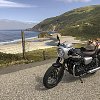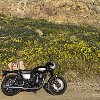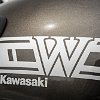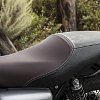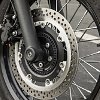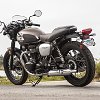The parallel-twin engine of the Kawasaki W800 purred under me as I gently nudged the handlebar left and right round each crescent of asphalt carved into the Pacific coastal cliffs. The bike and I were in a rhythm, waltzing along, happily taking in the green hillsides, the colorful flowers, and the deep blue ocean.
I was relieved to finally have made it to my favorite stretch of Highway One, a road I’ve traveled over and over many times during the past decade and a half. Usually, this lovely meandering path of tarmac is shared with friends, but this year, I decided to travel light, nimble, and solo. My one constraint was a late start in the day, meaning I didn’t even stop in Cambria for fuel before heading north until 4:30 p.m. I needed to pick up the pace.
I was riding to Carmel Valley to attend the yearly Quail Motorcycle Gathering, a bike show that features a wide selection of both classic and custom bikes. The new 2019 W800 Café, a lovely homage to café racers of the past with its “Metallic Magnesium Gray” tank and contrasting “Galaxy Silver” front cowl, felt like a perfect choice for riding to a classic bike show.

In addition to the Motorcycle Gathering, I got a last-minute invitation to join the Quail Motorcycle Ride, which takes place Friday before the show. I would be joining 99 of my closest friends and strangers, all aboard a variety of bikes new and old. But first I had to get to Carmel, which is almost 400 miles from home. So Thursday was dedicated to traveling up to the charming coastal area, and that required a couple hundred miles of freeway to start off. The mix of riding on my weekend trip provided a good first test of the Kawasaki W800 Café.
Riding the rise of retro
Kawasaki sold the similarly styled W650 (no fairing) in the United States for a couple of years and the bike developed a bit of a cult following, but until now we never got the updated W800 that sold for years in Europe. The W800’s U.S. debut capitalizes on the significant shift of market attention over the past 10 years from track-style sport bikes to more relaxed standards and café racers, not to mention the custom scene.

The W800's café racer ergonomics start with a seat height of 31.1 inches, a bit taller than your average cruiser, and a 57.7-inch wheelbase that's closer to the footprint of a sport bike. This means this modern vintage-style standard fits my 30-inch inseam just right, but is far more nimble than any cruiser. The seat is tapered toward the front, making it noticeably narrower than, say, my Triumph Street Twin. This is in stark contrast to the much wider fuel tank, which pushed my knees out further than I was expecting. But hey, at least it has rubber tank pads on the sides for my knees to grip.
At first glance, the W800 Café’s handlebar sits at a low, slightly aggressive angle. Reaching from the seat to the grips wasn’t a challenge, but after I had been on the road a while, my lower back certainly felt it. With that small front cowl, the crouched riding position made it easier to duck behind what little wind screen I had. And that little bit helped a lot. When I wasn’t tucked behind the front cowl, my head craned to keep from being pushed around, causing a fair amount of strain on my neck. But that’s the life of having zero to little fairing.

Taking off from a stop was effortless. Throttle response was quick but not jumpy, and the assist and slipper clutch felt light, with a comfortable friction zone. As I rolled onto the freeway, joining traffic was no issue. Kawasaki claims the W800’s 360-degree vertical twin pumps out 46.4 foot-pounds of torque, enough to merge with California freeway traffic, and there's enough horsepower and tall gearing to stay there comfortably. The bike just purred along, easily catching up to and passing traffic. When it came time to pull a quick passing maneuver, the café racer had enough oomph to get around every vehicle on the road. It’s not as snappy as other parallel twins in the segment, but it was capable.

I had to wonder if an upgrade of the W800’s exhaust would increase power output a bit. Two low-slung peashooter exhaust cans give the café racer both a classic look and a fairly tame sound — less aggressive growl, more docile purr. There is something to be said about having a neighborhood-friendly, quiet exhaust that allows you to leave your house, or return from a late night out, in the wee hours without waking anyone up. But I would be curious to see if the bike could be more lively with something that would let it breathe a bit more.


When I did find that smoother asphalt, the W800 offered decent turn in and respectable handling. Leaning into a corner, I never felt like I was fighting the bike; it was just smooth and easy. The twin rear shocks are adjustable for preload and the fork offers no adjustments. The suspension overall felt just a bit soft, but it never threw me off course mid-turn. Rolling over the rough sections of Highway One, where the road had been patched from landslides and shifts in the pavement, the slightly softer suspension was welcome, though mildly bouncy. Overall, the W800 offered a comfortable ride.

New bike, vintage meet, and a few laps
After a handful of stops to take in the view, and making my way through some tourist traffic on Highway One, I made it to Carmel after sunset, but before the sky was completely dark. The following day I met up with a crowd of other riders at the Quail Lodge, and we set out on a ride around the Monterey Peninsula. The temperature was perfect, the morning fog had lifted, and the hills were green, welcoming the throng of bikes as we zipped along Carmel Valley Road, further and further east.
During our mid-morning stop at a local winery, many fellow riders approached the W800 and asked, “What year is that?” When I told them it was a brand-new 2019 model, they were almost in disbelief.

“I thought for sure that was an old bike!” one of the Boomer-age riders exclaimed enthusiastically. Kawasaki really hit the nail on the head with the styling, enough to stop a handful of people in their tracks to admire and comment.
We saddled up again and continued on to Weathertech Raceway Laguna Seca. The mild morning chill had burned off by then, and we lined up to take parade laps around the track, warming up in the midday sun. There was a buzz as all the riders eagerly anticipated getting on track.
Our pace car finally flicked its flashing lights on and we all followed onto the tarmac. After the first lap, returning back to the corner we had entered, it became clear we had caught up with the tail end of our very large group of riders. A bit of mayhem ensued, as riders decided this was the green flag to rip around the course at whatever speed they liked. Getting caught up in the pace of the spirited riders, I charged uphill along the back straight just before turn seven. It was exciting approaching the top of the famed corkscrew, and the W800’s slipper clutch made downshifting uneventful. Grabbing a handful of the right lever, the two-piston caliper bit down on the single 320 mm front brake disc and I was reminded I was not on a sport bike. I also reminded myself I wasn’t wearing leathers or sport boots. Time to dial it back.

I finished the four or five laps (I’m sure we took liberties and went a few times more than they had planned) alongside my fellow Quail Ride participants, and we pulled off track, exiting back out turn five. Eventually, we made our way over the Laureles Grade and back west along Carmel Valley Road, returning to the Quail Lodge for lunch and the end of the ride. It had been a thoroughly satisfying experience, riding through some of the area’s best roads and scenery.

The W800's spot in the retro world
The rest of the weekend was full of lots of interesting classic bikes and familiar faces. Sunday morning came far too quickly, and it was time to head home. The return trip was uneventful, except for a spit of rain that just reminded me it was still springtime. The W800 garnered attention at most of the stops I made along the way. It’s a fun, great-looking bike, comfy enough for a Saturday ride. I’m not sure I would recommend it for touring, but it wasn’t punishing like an actual sport bike would be.
At $9,799, it’s a bit on the pricey side. That places it between its British competitors: a few hundred more than the Street Twin, at $9,100, but less than the Street Cup, at $10,500. It's less than Ducati's Scrambler Café Racer at $11,995. The Royal Enfield Continental GT I tested earlier makes a little less power but it also weighs 50 pounds less, so it feels spunkier than the Kawasaki. The Royal Enfield also costs much less, at a starting price of $5,999, so that makes it an attractive option, in my view.
All that puts the Kawasaki somewhere in the middle of the range of options for a modern café racer. If you like the traditional styling and want to get in on the café racer scene, the W800 Café gets the job done.
| 2019 Kawasaki W800 Café | |
|---|---|
| Price (MSRP) | $9,799 |
| Engine Type | Air-cooled vertical twin, four valves per cylinder |
| Displacement | 773 cc |
| Bore x stroke | 77 mm x 83 mm |
| Compression ratio | 8.4:1 |
| Torque | 46.4 foot/pounds @ 4,800 rpm |
| Transmission | Five gears |
| Front suspension | 41 mm fork; 5.1 inches of travel |
| Rear suspension | Twin shocks, adjustable spring preload; 4.2 inches of travel |
| Front brake | Single 320 mm disc, two-piston caliper, ABS |
| Rear brake | Single 270 mm disc, two-piston caliper, ABS |
| Tires front/rear | 100/90-18; 130/80-18 |
| Steering head angle/trail | 26 degrees/3.7 inches |
| Wheelbase | 57.7 inches |
| Seat height | 31.1 inches |
| Tank capacity | 4.0 gallons |
| Curb weight | 489.5 pounds |





